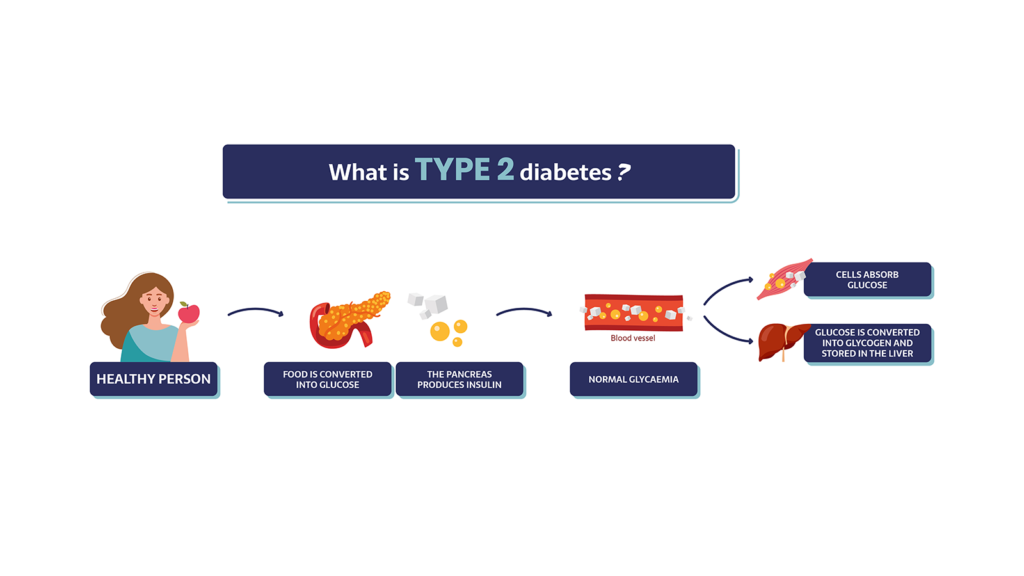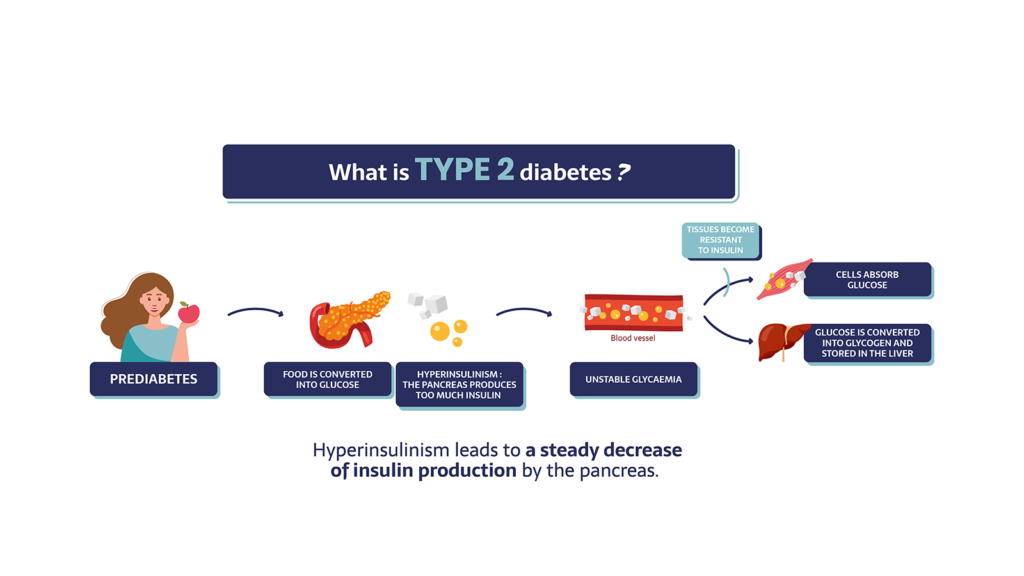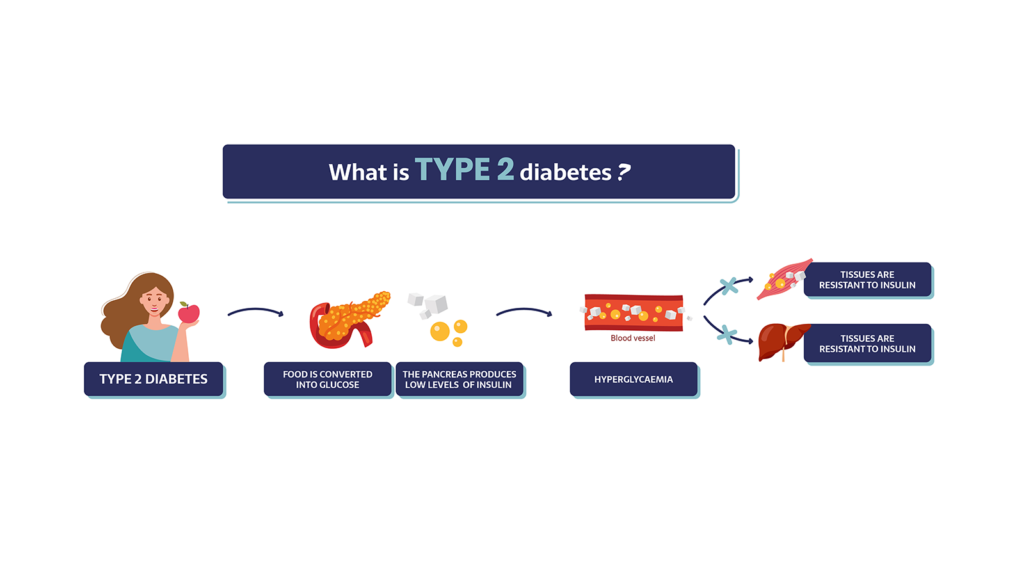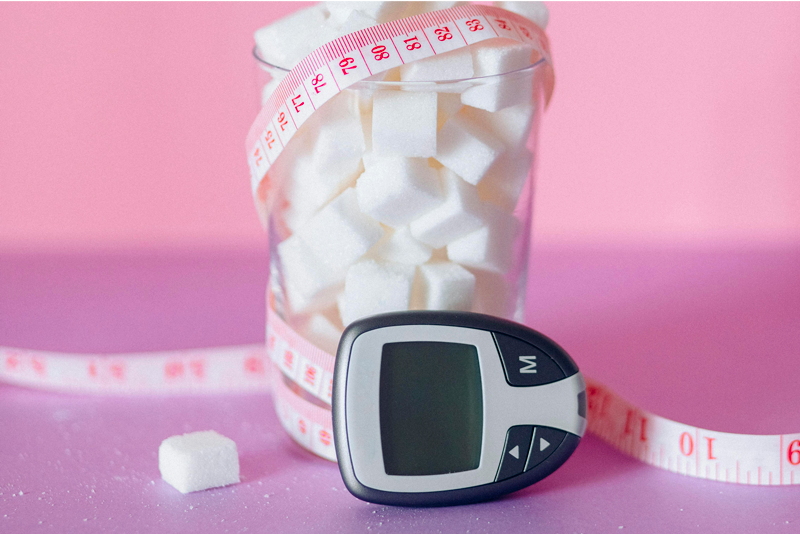
Diabetes summarised
in three diagrams
To better understand the mechanism of diabetes, let’s look at these three diagrams. In the first, we follow the process of glucose uptake in the body of a healthy person. The second shows a situation in which disorders are noticeable in someone with prediabetes. Finally, the last diagram explains the complications experienced by patients with type 2 diabetes.

« Healthy » status
When a healthy person eats a balanced diet, complex sugars are broken down during the digestion phase. Then, enzymes in the gut convert them into glucose. Finally, the cells of the pancreas produce a hormone called insulin. This regulates the level of glucose in the blood, also called glycaemia.
Glucose plays an essential role in the body as it is serves as the ‘fuel’ for all the cells in our organs. Glucose also converts to glycogen and accumulates in this form in the liver and muscles. These stores act as a source of reserve energy which can be redistributed to the cells. Logically, blood sugar levels drop once assimilation is complete.
« 2/3 of diabetics live in urban areas »
– www.idf.org : Diabetes facts & figures

« Prediabetes » status
Still poorly understood, prediabetes does not refer to a disease, but relates to a state of imbalance in the body’s blood sugar levels. For the moment, the diagnosis of prediabetes remains rare, due to the lack of apparent symptoms. Glucose increases in the body and leads to a situation of hyperglycaemia. In an attempt to control glucose, the body calls for increased insulin production. In this case, the cells of the pancreas work harder at the risk of being overloaded. Another phenomenon that results from these disorders is that cells and tissues gradually show resistance to insulin.
After a few years, the patient begins to feel the effects of type 2 diabetes. Their blood sugar levels become increasingly unstable. Awareness during the prediabetes phase can reduce or even prevent future diabetes. This is why eliminating risk factors is so important. Treatment of obesity or overweight, a return to a healthy diet and physical activity are generally sufficient to reverse the trend. If symptoms or the beginnings of complications appear, it is imperative to consult a doctor.

« Diabetes » status
Type 2 diabetes occurs when the fasting blood sugar level is greater than or equal to 1.26 g per litre of blood. This results in daily hyperglycaemia in the body. In order to properly absorb glucose in the blood,the pancreas responds by secreting higher levels of insulin. Eventually, the body enters a phase of hyperinsulinism, where too much insulin is present. This has two consequences.
- Making so much insulin, the pancreas becomes exhausted, which means it is increasingly less able to produce the hormone. Sometimes the pancreas just cannot make it anymore.
- If too much circulates in the blood, insulin eventually becomes powerless. Tissues, muscles and the liver develop a resistance to the hormone.
This leaves the field open for glucose, which colonises the whole body.
Hyperglycaemia then establishes irreversible type 2 diabetes. Patients with type 2 diabetes experience complications throughout their lives. Continuous medical monitoring and taking medication-based treatments are obligatory.

Continue reading :
- What is diabetes?
- How is diabetes diagnosed?
- Who is affected and what are the health risks?
- What are the symptoms of type 2 diabetes?
- What is the difference between diabetes and prediabetes?
- Type 2 diabetes: the role of food
- The role of physical activity in combatting diabetes
- Managing stress to avoid type 2 diabetes
Our latest publications
Want to learn more about topics related to blood sugar management?
Here are our most recent blog posts!


Contact information
51 Avenue F. Lobbedez
CS 60946
62033 Arras Cedex
France
Tel : +33 (0)3 21 23 80 00
Fax : +33 (0)3 21 23 80 01




